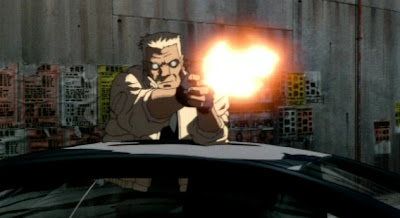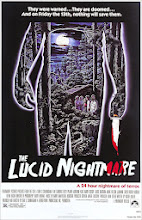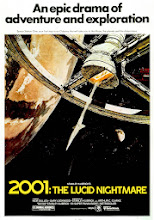Director: Mamoru Oshii
Year 1995
Ghost in the Shell is a fantastic science fiction animated film that delves into the true essence and meaning of life by commenting on the possibility of machines becoming something more than just soulless creations. This evolutionary step in both animated features and thought-provoking storytelling is a shining example of how filmmakers can use the medium to create some rather inspiring narrations on the human condition, both in its significance and unprecedented ramifications. Filled with action, beautiful artistry, and an intriguing plot, Ghost in the Shell is not only a masterpiece, but it’s a classic example of how truly complex an anime can be.
Set in the year 2029, the film follows a team of high-level government operatives lead by a tough as nails female cyborg cop named Motoko Kusanagi, as they police a cyber-punk metropolis for malicious anarchistic hackers aiming to disrupt society. Their recent case has them hot on the trail of an illusive and notorious cyber hacker named ‘The Puppet Master’, who is wreaking havoc across the interactive network which is connected to all of the people of Earth. What makes this miscreant’s actions that much more alarming, is that they seem to have an unhealthy fixation on Major Motoko Kusanagi and her relevance to being a cyber-genetic creation. As they narrow in on their suspect, they come to a shocking realization that ‘The Puppet Master’ may be far more complex and unsettlingly then they ever bargained for. One thing’s for sure, the world won’t be the same once this mysterious hacker’s true intentions come to light.
With the metaphorical connections in place and the stage set, Oshii pushes the visual look of the film into uncharted territories as he allows the grungy nature of this world to spring to life in the most expressive of ways. From the darkened back alleys to the neon caked and congested streets of the city, the lived in nature of this fictional world is exceptionally crafted. Through this meticulous recreation, born from Oshii’s mind, we really get a chance to feel the age of the expansive metropolis and it’s the detailed way in which he introduces us to each various location that really builds up the history of this technologically driven world. Not only do we get to visit the thriving portions of the city, like the looming skyscrapers and corporate headquarters, but we also get to see the more traditional and weathered side of this aged society. The best example that showcases the visual scope of the landscape is the precious moments in which we get to traverse through the film’s less refined locations. For instance, the chase scene that occurs in the marketplace, where the crew is chasing down a suspect, is one of the most visually impressive moments of the film, allowing us to revel in the sheer wonder and scale of the world at hand. I absolutely loved the look of the packed shopping district, filled with its diverse characters and kaleidoscopic colors, and the closing moments of the scene really gives the viewer a feast for the eyes, not to mention a miraculous fight sequence.
It is in this shocking and visceral moment, filled with painfully perverse gore, that we are presented with one of the film’s most poignant images. We watch the mangled Motoko as she lay disjointed on the ground and we are taken aback by the realness of the moment. Though she is just a machine and conceivably without a soul, we still relate that humanistic trait to her and we sympathize with the predicament that she is in. It’s this strange conundrum that drives the entire series up to this point. Are machines more than machines? Can they evolve into something else entirely, even without the aid of the ones which created it? As her human cover is stripped from her body, we still come to compare her to human because of the actions that follow this pinnacle moment. This instance is a great bridge to the overall arc of the story, and what continues is a revelation that truly feels inspired while still managing to maintain a certain esteem of mystery and wonder. With its unapologetic approach and masterful storytelling, Ghost in the Shell is a science fiction animation that really raises the bar on animated features.
With its heavy dose of cyber punk style and its tendency to get a little gritty and disturbing, Ghost in the Shell tells an intriguing story about the evolution of man and the inherent plausibility that the things that we create could somehow become equal to us. In this nightmare scenario, the filmmakers decide to bridge the gap between man and machine by establishing a world where technology and humanity are at a merging point. The union of these two entities, though bloody and foreboding, is exceptionally crafted and even though there is a great deal of violent, bombastic flair, the story is surprisingly spiritual as it goes about spinning a yarn about the soul of a machine and the evolution of life as we know it. Simply put, Ghost in the Shell is one…..
 |
| Ewww! Gross! |
 |
| She's just not feeling the horseshoe dude. |
 |
| There's a lot of gun fire in this flick. |
 |
| Seriously! Tons of gun fire! |
 |
| Hey shithead... start shooting that gun! |
 |
| Bato is like the Arnold Schwarzenegger of Anime characters. |
 |
| Am I digging the stache, goatee, glasses trifecta? Shit yeah! |
 |
| Bato is a little shy around naked butts. |
 |
| Talk to the robot hand. |
 |
| I don't know what the hell is going on here, but damn is it heavenly. |
 |
| Nothing like getting kicked in the face by a hot, naked, and invisible chick. |
 |
| Well at least we were able to salvage the best parts. |
 |
| I bet that dude is about to shoot that gun off. |
 |
| This guy is having a bloody good time. |
 |
| The itsy bitsy spider tank shot up the place to shit. |
 |
| The horror! The HORROR! |
 |
| Could you not do that? You're really creeping me out. |
 |
| What a horrible time to lose one's head. |






























































































No comments:
Post a Comment